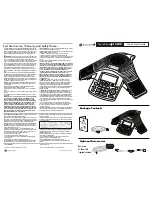
PB-48 PATCH BAY SYSTEM
5
another device via the upper front panel jack. The upper front jack allows a signal
split, or mult, just as a Y-cord would do.
When one end of a patch cord is inserted into the lower front panel jack, the
switch breaks the connection between the corresponding rear panel jacks, as
shown in Figure 3. This means that you can interrupt the signal that flows between
the upper and lower rear jacks, and re-route it to another destination with a patch
cord. Using our earlier example of a mixer output connected via the rear panel to a
recorder input, with two patch cords you can insert a device, such as an equalizer,
between the mixer output and the recorder input.
Non-Normalled
Non-normalling is the most common customization you may wish to make
to one or more of your PB-48's vertical pairs. For example, if you have an equalizer
that is not part of the normal setup, it may be convenient to connect its input and
output to the same vertical pair (as shown in Examples 1 and 3 on page 6),
but
without the input and output being connected together by the normal link
. (If such
a connection were allowed to exist in equipment that is idling, it could cause harm-
ful feedback or oscillation.)
In a non-normalled pair, as shown in Figure 4 below, a front panel upper jack is
connected only to its corresponding rear panel upper jack, and the front panel
lower jack only to its corresponding rear panel lower jack, with no link between the
two. To configure one or more jack pairs this way, please see Customizing on
page 7.
Full-Normalled
In a Full-Normalled pair, both front panel jacks would have a switch, and plug-
ging a patch cord into either the upper or lower front panel jacks would interrupt
the signal between the corresponding rear panel jacks. Full-normalled patch bays
are a relic of the past, and are rarely implemented nowadays because the mult
feature of the top front jack is lost, and no particular advantage is gained. In any
case, because PB-48 modules do not have switching jacks in the top front posi-
tions, the full-normalled configuration is not possible.
Figure 4
Figure 3
All manuals and user guides at all-guides.com






























